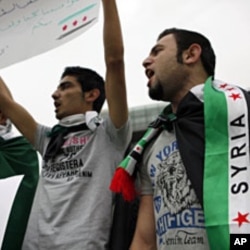Unrest picked up again Friday in Syria, with large opposition demonstrations reported in Homs, Hama and other opposition strongholds, as well as by ethnic Kurdish protesters in Qamishli.
Rights activists said government forces killed at least 10 people across the country. The opposition Syrian Observatory for Human Rights said at least three of the deaths occurred in the Hama region after forces opened fire on a vehicle.
Photo gallery
The year-long crisis has exposed some of the fundamental fault lines in the country, including ethnicity and sectarianism.
Syrian Kurds gathered in Qamishli Friday for an anti-government demonstration, part of what appears to be a continuing movement of Kurds into the opposition fold.
While the extent of the ethnic group's participation is debated - limited access to the region makes popular sentiment too hard to assess - protests like Friday's in the northeastern city highlight long-standing resentments of groups across the nation.
Minorities speak out
Kurds, as well as Armenian and other minority ethnic groups make up about ten percent of the population in this Arab majority nation. There is also a diversity of religious groups; about ten percent are Christian, while Muslims are split between Sunnis, Shia-derived Allawites, and Druze.
The government, dominated by minority Allawites, has portrayed the conflict as partly sectarian driven, rather than a popular uprising against decades-long autocratic rule. The state argues Sunni extremists cross the border from Iraq and elsewhere to carry out what it calls terrorist activities and foment sectarian divides.
Anti-government forces stress that they are an inclusive group, and point to members of all Syrian ethnic and religious groups as proof that their motives are political.
But reprisal killings of Sunni and Alawite civilians in the most restive areas have added to fears of sectarian divides, now that the once-peaceful protests have been overshadowed by the opposition's military wing.
In Damascus, university student Zain, who gave just his first name, seconded the idea of sectarianism as a driving force. He spoke in the presence of a government official, known as a minder, who accompanies foreign journalists.
“Of course and a lot of the problems as we say are religious," he said. "Anyone that starts to see that you are this type, you belong to this group and the other belongs to this group, things will be distressed.”
Zain blamed other nations, in particular the United States, of trying to play up the divides, arguing instead that in the end, “we are all Syrians.”
But fellow student Nour el-Ibrahim argued that while sectarianism has caused problems, there is far more to Syria's problems.
Also speaking in front of a minder, she agreed that a foreign conspiracy is behind growing sectarianism. But she pinned half the blame on Syrians themselves, starting with the government as well as the public. Mistakes, she said, have been made.
An opposition funeral Friday in a Damascus suburb was a reminder of those “mistakes.” As the death toll in the conflict continues to climb - now estimated at more that 9000 killed - both sides become more entrenched, as do any signs of differences between them.
UN sees small signs of progress
U.N. observers in Syria are continuing to work toward an end to violence between government forces and rebels despite a fractured cease-fire.
A spokesman for international envoy Kofi Annan, who brokered the cease-fire plan last month, said it was "on track," despite continued violence.
Ahmad Fawzi told reporters in Geneva there are some small signs of progress.
"There are no big signs of compliance," he said. "There are small signs of compliance. Some heavy weapons have been withdrawn. Some heavy weapons remain. Some violence has receded. Some violence continues."
On Thursday, at least two dozen people died in anti-government related unrest, including four civilians at Aleppo University.
Witnesses said pro-government students armed with knives attacked protesters at the university before security forces swept in, firing tear gas and live ammunition.
The violence has erupted as Syria prepares for parliamentary elections on Monday, under constitutional reforms that have allowed the creation of new political parties.
World powers, meanwhile, have been tightening economic pressure on Syrian leaders and the government. On Friday, U.S. Secretary of State Hillary Clinton urged China to consider additional penalties against the Syrian government.
The State Department released her remarks as she completed talks with high-level officials in Beijing. Both China and Russia have voiced reservations about imposing new sanctions on Syria through the U.N. Security Council.














